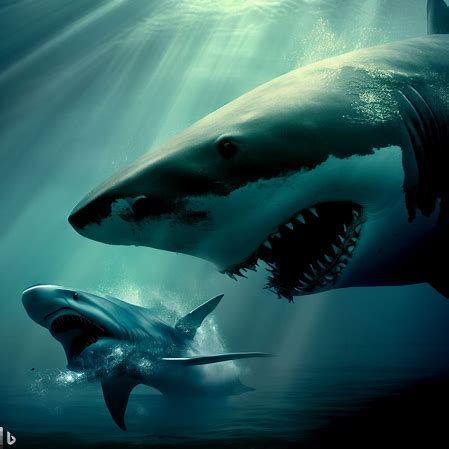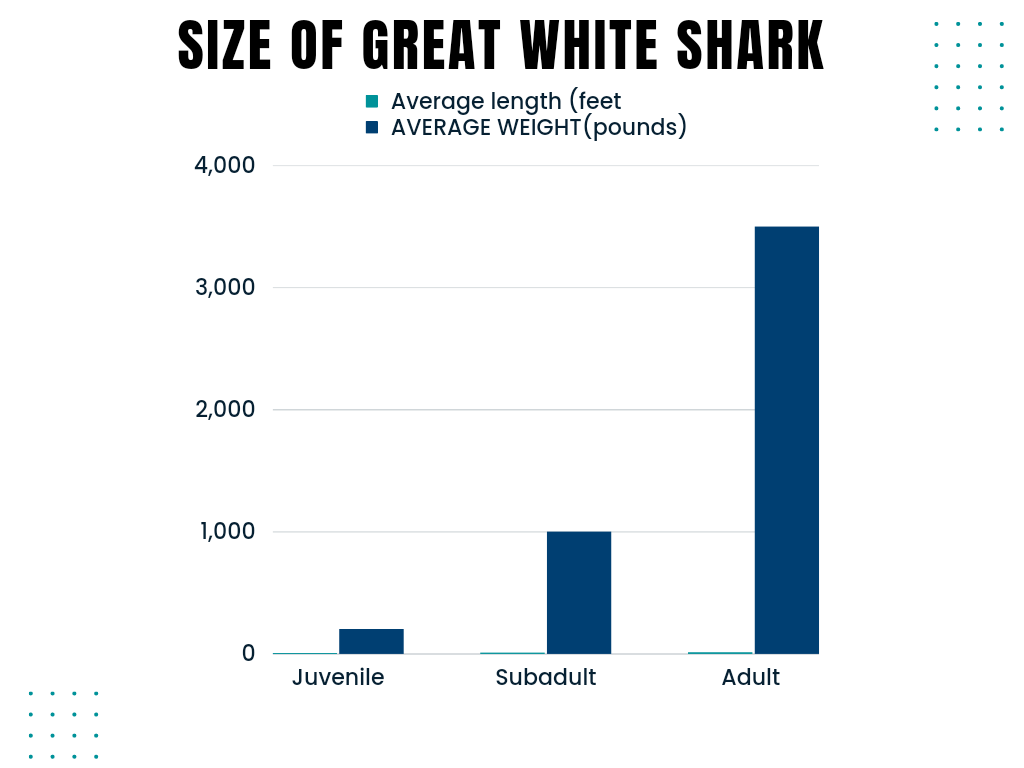
Key Takeaways
- The Great White Shark and the Megalodon are both formidable predators, but they lived in different time periods.
- The Megalodon was much larger than the Great White Shark, with estimates suggesting it could grow up to 60 feet in length.
- The Megalodon had a more powerful bite force than the Great White Shark, allowing it to prey on larger marine animals.
- The Great White Shark is still alive today and is considered one of the most dangerous sharks in the ocean.
- The extinction of the Megalodon is still a topic of debate among scientists, with theories ranging from climate change to competition with other predators.
- Despite their differences, both the Great White Shark and the Megalodon play important roles in maintaining the balance of marine ecosystems.
- Understanding the differences between these two sharks can help us appreciate the diversity and evolution of marine life over millions of years.
The ocean depths are home to two giants – the Great White Shark and the mighty Megalodon. These awe-inspiring predators invoke fear in all who consider their colossal size and ferocious nature. Let’s explore their characteristics, habitats, and ponder – who would win in a battle?
The Great White Shark (Carcharodon carcharias) has sharp teeth, streamlined body and incredible swimming speed. The Megalodon – largest shark ever known – was a behemoth with estimated lengths reaching up to 60 feet or more.
The Great White Shark is found in coastal waters worldwide, whilst the Megalodon inhabited prehistoric oceans with higher sea levels and warmer waters.
Who would emerge victorious in this epic showdown? Science provides theories, but the true answer will forever remain a mystery from ancient times.
Prepare for the adventure of a lifetime! Get set to be awestruck by the power of Great White Sharks and the immense Megalodon. Are you ready?
Background information on Great White Sharks
Great White Sharks, or Carcharodon carcharias, have fascinated scientists and adventurers for centuries. They are key to marine ecosystems and possess unique features.
Their size is remarkable. They can reach 15 feet and weigh up to 5,000 pounds! Their streamlined bodies let them swim swiftly and precisely.
Plus, they have multiple rows of serrated teeth – up to 300! This enables them to eat seals, dolphins, sea lions, and even other sharks. It’s why they are known as apex predators.
Also, their sense of smell is astonishing! They can detect the faintest scent of blood from miles away. This helps them find meals with accuracy. It earned them the nickname “white death” in some cultures.
So, before you venture into the world of Megalodons, remember: Great White Sharks are like guppies compared to them – be careful!
Background information on Megalodons
The Megalodon, a prehistoric shark that once roamed the oceans, has intrigued many. Estimated to be up to 60 feet long, these apex predators boasted an impressive bite force. Their teeth could reach up to 7 inches in length and were perfect for crushing the bones of their prey such as whales and other large marine mammals.
What sets the Megalodon apart is their amazing adaptability. Fossils have been found all over the world, suggesting they were able to thrive in shallow coastal areas and deep waters alike.
Their extinction, however, is still a mystery. It is believed that they disappeared around 2.6 million years ago during the Pliocene era, though climate change and competition for food may have played a role.
Size and Appearance

To better understand the size and appearance of great white sharks versus megalodons, let’s delve into the sub-sections – the size of great white sharks and the size of megalodons. Discover how these majestic creatures differ in terms of their physical dimensions and get insights into the impressive proportions they possess.
Size of Great White Sharks

Great White Sharks are known for their size and looks. They can get really big – from 15 to 20 feet long and weigh up to 5,000 pounds. This makes them the largest predatory fish in the ocean!
Here’s a table of their average length and weight according to their life stage:
| Life Stage | Average Length (feet) | Average Weight (pounds) |
|---|---|---|
| Juvenile | 8-10 | 200-300 |
| Sub-adult | 12-14 | 1,000-2,000 |
| Adult | 15-20 | 3,500-5,000 |
Pretty cool, right? As Great White Sharks grow, they get bigger and heavier.
Plus, they have some special features. Their bodies are sleek and strong. They also have lots of sharp teeth that keep growing back.
Don’t forget: When you see a Great White Shark in its habitat, stay away and be still.
Now, let’s explore the incredible size of megalodons!
Size of Megalodons
Megalodons were colossal prehistoric sharks that lived millions of years ago. They amazed scientists and enthusiasts alike with their immense size and appearance.
Their size was awe-inspiring, with juveniles reaching 30-40 ft. long and weighing 13-20 tons. Adult females were 45-55 ft. long and weighed 60 tons, while adult males were 52-60 ft. long and 70 tons. Astonishingly large!
Megalodons had unique characteristics too. Their teeth were bigger than any other shark species, reaching up to 7 in. long for catching and eating large prey.
Researchers suspect that megalodons had an incredibly powerful bite force. This enabled them to easily crush the bones of their food, making them effective predators.
These titans once dominated the oceans millions of years ago. Paleontologist Peter Klimley believes their bite force could exert a pressure of 10 tons per square inch – an amazing feat unmatched by any other creature.
We’re still captivated by megalodons today. We research and discover to understand their extraordinary lives and the secrets they left behind.
Diet and Feeding Habits
To better understand the diet and feeding habits of great white sharks and megalodons, delve into their respective sub-sections. Explore the distinct ways in which these predators acquire their sustenance in their natural habitats. Witness the fascinating strategies employed by great white sharks, and uncover the unique feeding behaviors of megalodons.
Diet and Feeding Habits of Great White Sharks
Great white sharks have fascinating diets and feeding habits. They’re known as apex predators for their voracious appetites. Their diet mostly consists of marine mammals like seals, sea lions, and small cetaceans. Plus, they also eat large fish species like tuna and rays.
These sharks use an “ambush predation” strategy to catch their prey. They have strong jaws filled with sharp teeth to tear apart their targets. They’re also good at scavenging, feeding on floating carcasses in the ocean.
What’s more, they have special organs called ampullae of Lorenzini that detect electromagnetic fields from potential prey – even in murky waters!
In 1916, a series of attacks by a great white shark along the Jersey Shore caused panic among beachgoers. This event inspired Peter Benchley’s novel “Jaws”, and changed people’s view of these sharks as ruthless killers.
Diet and Feeding Habits of Megalodons
Megalodons were colossal prehistoric sharks, notable for their formidable diet and feeding habits. Their diverse prey and various hunting techniques made them majestic creatures. Let’s explore their diet and feeding habits!
The following table displays the diet and feeding habits of Megalodons:
| Prey | Hunting Technique |
|---|---|
| Marine Mammals | Ambush Predation |
| Large Fish Species | Active Hunting |
| Giant Turtles | Stealth Attacks |
| Smaller Sharks | Striking with Precision |
| Whales | Cooperative Predation |
Megalodons used ambush predation to hunt marine mammals, and active hunting against large fish species. Stealth attacks and striking smaller sharks with precision showed their adaptability. When chasing huge targets like whales, they engaged in cooperative predation.
Their extraordinary dentition helped them manipulate and devour prey. Their blade-like teeth could slice through flesh, allowing them to quickly incapacitate their victims.
Dr. Stephen Godfrey from Calvert Marine Museum estimated that an adult Megalodon could consume up to 2,500 pounds (1,134 kg) per day due to its size.
The diet and feeding habits of Megalodons reveal their unrivaled dominance as apex predators. They give us valuable insight into the prehistoric era, and invite us to explore further into the mysteries of the past.
Habitat and Distribution
To gain a better understanding of the habitat and distribution of both great white sharks and megalodons, explore the sub-sections: habitat and distribution of great white sharks, and habitat and distribution of megalodons. These insights will shed light on where these powerful creatures dwell and the geographical areas they can be found.
Habitat and Distribution of Great White Sharks
The Great White Shark, also known as Carcharodon carcharias, is found in coastal and offshore waters worldwide. Famous for their immense size and predatory behaviour, they’re commonly seen in temperate waters like South Africa, Australia, California, and the Mediterranean Sea. These majestic creatures often visit areas with plenty of prey, so they’re a powerful presence in places packed with seals, sea lions, and other marine mammals.
They can be seen in both warm and cold waters all over the globe. Even though they prefer cooler temperatures, some of them have been seen in tropical areas during migration or when they’re chasing prey.
What sets them apart is their incredible ability to survive in different habitats. They move easily through rocky reefs, kelp forests, and open ocean environments.
Remember: If you join a cage diving expedition or boat trip to see Great White Sharks up close, you must focus on safety and respect their natural habitat.
Habitat and Distribution of Megalodons
Megalodons – ancient apex predators of the seas – lived in various places around the world. They were comfy in both warm and cold waters, from coastlines to open oceans. They roamed the planet for millions of years – from the Miocene to Pliocene epochs – around 23 to 2.6 million years ago.
Their presence was wide-spread. Fossil evidence showed up in North and South America, Europe, Africa, Asia and Australia. This suggests they were everywhere in different oceanic realms.
They liked shallow coastal waters. It was like a buffet for them – seals, dolphins, whales and large fish. Megalodons lurked close to shorelines, dominating the ecosystem with their superior size and strength.
But they ventured into deeper waters too. It’s believed they went as deep as necessary to catch prey in offshore or pelagic environments. This ability let them tap into various niches in the marine food web.
Fossil records and paleontological studies give us insight into megalodon’s habitat and distribution. By studying sediment layers and comparing the geographical locations of their remains, researchers can learn more about these giants who once ruled the oceans.
Extinction and fossil record: history turned into a ‘oops, we messed up’ museum.
Extinction and Fossil Record
To better understand the extinction of Megalodons and the scientific discoveries surrounding the fossil record, explore this section. Learn about the distinct sub-sections that delve into the extinction of Megalodons and the fascinating insights provided by the fossil record.
Extinction of Megalodons
The giant sea creatures known as Megalodons vanished from Earth millions of years ago. Let’s explore their true extinction story.
To investigate the disappearance of Megalodons, we can create a table of key factors that contributed to their extinction:
| Factors | Description |
|---|---|
| Climatic Changes | Global climate shifts influenced the availability and spread of prey for Megalodons. |
| Competition | More competition for food resources with other marine predators could have led to Megalodon extinction. |
| Decline in Prey | Decreasing populations of large marine mammals, Megalodons’ main food source, could have affected them. |
| Oceanic Conditions | Changes in ocean temperature and salinity could have had a negative effect on Megalodon survival. |
These factors show some of the significant elements responsible for Megalodons’ disappearance.
Recent studies suggest their population dwindled gradually, not suddenly. This gradual decline gives us an idea of how environmental changes and biological factors interacted over time.
We still don’t know much about this secretive species. Join us on this exciting journey as we uncover more mysteries about the extinction of Megalodons!
Unearthing the fossil record is like reading a 500-million-year-old social media post, with extinction events and strange messages from dinosaurs.
Fossil Record and Scientific Discoveries
Fossil records and scientific discoveries have been real eye-openers in terms of understanding life on Earth. Through careful research and analysis, scientists have discovered a lot about ancient organisms and their habitats.
Let’s take a look at a table of some amazing findings. This visual representation shows the size and diversity of each discovery.
| Fossil Discovery | Location | Estimated Age |
|---|---|---|
| Archaeopteryx | Germany | 150 million |
| Tiktaalik | Canada | 375 million |
| Tyrannosaurus rex | USA | 65 million |
These are just a few of the incredible discoveries made. The fossils found around the world show us ancient ecosystems with creatures that don’t exist anymore.
Archeopteryx is a remarkable example. It had both bird-like and reptilian features, proving evolutionary theories. Its discovery in Germany around 150 million years ago changed our understanding of bird evolution.
Every scientific discovery from the fossil record adds new chapters to Earth’s old history. As researchers uncover more details, they help us learn more about prehistoric life forms and their amazing stories.
Pop Culture and Media Representation
To better understand the pop culture and media representation of great white sharks versus megalodons, delve into their respective influences. Explore the impact of great white sharks in pop culture and media, as well as the influence of megalodons in pop culture and media. Uncover how these creatures have captured our collective imagination and left an indelible mark in various forms of media.
Influence of Great White Sharks in Pop Culture and Media
Great White Sharks have had a huge impact on pop culture and media. They’ve enthralled people’s imaginations, with feature roles in movies like “Jaws”, documentaries such as National Geographic’s “Shark Week”, books that explore their behavior and more! Plus, they even have their own merchandise, with t-shirts, keychains and posters featuring their menacing image. On social media, Great Whites are also a hit, with users sharing images and videos of these powerful creatures.
Moreover, these sharks are ambassadors for marine conservation, highlighting the need to protect our oceans and biodiversity. To continue this influence in pop culture and media, we should:
- Promote educational initiatives to teach younger generations about shark conservation.
- Collaborate with filmmakers to make captivating documentaries.
- Sponsor art exhibitions of artwork featuring Great White Sharks.
- Engage celebrities and influencers to promote responsible tourism.
- Fund research to discover more about these creatures.
These efforts would not only entertain, but also raise awareness about the importance of shark conservation. It’s essential to create initiatives that engage people emotionally and intellectually, motivating them to help protect Great White Sharks. Even extinct apex predators can’t resist a cameo in the world of pop culture!
Influence of Megalodons in Pop Culture and Media
Megalodons have left a lasting impression in the world of pop culture and media. From movies to books and video games, their influence can be seen in many forms of entertainment. Let’s take a closer look at how these ancient giants have impacted our modern-day artistry.
Movies like ‘The Meg’ (2018) and documentaries like ‘Megalodon: The Monster Shark Lives’ (2013) have captivated filmmakers and audiences alike. Steve Alten’s novel ‘Meg’ also dives deep into the fantastical world of megalodons. In the gaming sphere, ‘Hungry Shark Evolution’ allows players to experience the unique power of these creatures.
To further explore the influence of megalodons in pop culture, consider these ideas:
- Hold a Megalodon Film Festival: Showcase classic shark-themed movies and newer releases like ‘The Meg’, bringing fans of these ancient predators together.
- Create Interactive Exhibitions: Work with museums and aquariums to create interactive displays that educate visitors about megalodons.
- Publish Educational Materials: Develop books and online resources that provide information about megalodons in an accessible manner, inspiring readers of all ages.
Let’s keep celebrating the influence of megalodons in pop culture. After all, in this land of Kardashians and cat videos, anything is possible.
Frequently Asked Questions
1. Q: How does the size of a Great White Shark compare to that of a Megalodon?
A: The Great White Shark typically grows up to about 20 feet in length, while the Megalodon was estimated to reach an astonishing length of around 50-60 feet.
2. Q: Are Great White Sharks still alive today?
A: Yes, Great White Sharks are still present in today’s oceans. While their population is declining, they can still be found in various parts of the world, particularly in coastal areas.
3. Q: Did the Great White Shark and the Megalodon coexist?
A: No, the Megalodon became extinct around 2.6 million years ago, while the Great White Shark emerged much later. They never shared the same time period in history.
4. Q: How do their diet preferences differ?
A: Great White Sharks primarily feed on marine mammals like seals and sea lions, as well as fish. In contrast, the Megalodon likely had a more diverse diet, including large marine animals like whales.
5. Q: Which species had a more powerful bite?
A: The Megalodon had an incredibly powerful bite, estimated to be the strongest of any known creature. Its bite force is believed to have been around 10-18 times stronger than that of a Great White Shark.
6. Q: Can Great White Sharks be considered descendants of the Megalodon?
A: While it is quite possible that Great White Sharks share some ancestry with the Megalodon, they are not direct descendants. Both species belong to the same scientific order (Lamniformes), but they branched off into separate lineages millions of years ago.
Conclusion
The Great White Shark and the colossal Megalodon indeed share a fierce predatory nature. Both possess remarkable hunting capabilities and unmatched power in their respective environments. Differences exist, however. The Great White Shark is renowned for its agility and speed, enabling it to swiftly pursue its prey. The Megalodon, on the other hand, is colossal in size and strength, making it an unparalleled force in ancient seas. Its massive jaws and fearsome teeth could easily overpower any foe.
Delve further into this captivating topic and uncover fascinating facts never before explored. The Great White Shark may be smaller, yet its adaptability makes it a formidable predator throughout history. Its capacity for evolution and survival in diverse habitats is a testament to its tenacity. The Megalodon’s existence during prehistoric times reminds of a period when creatures of unimaginable proportions roamed the oceans.
These awe-inspiring creatures make one long for more knowledge about their untold stories. What secrets remain hidden beneath the waves? Our thirst for discovery leads us to uncover new insights into Earth’s past inhabitants and appreciate the wonders of our planet.
References




